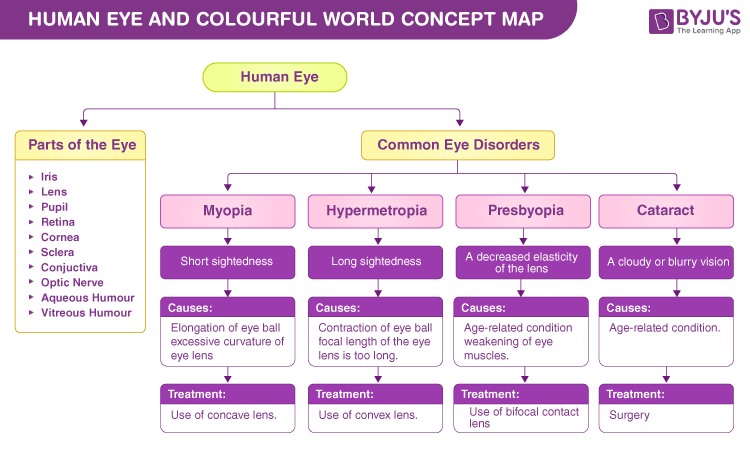The human eye and colourful world concept map help students learn in-depth about the different parts of the eye in the human body. This concept map makes learning more interactive. Moreover, concept mapping assists students in visualising the features, their functions, and their significance. Students can also learn about the different defects of vision and their corrections in this concept map.
Human Eye
The human eyes are the most complex sense organ in the human body, which comprises several parts to form a spherical structure. The structure of the human eye can be primarily classified into external structure and internal structure. Every aspect of the human eye is mainly responsible for a specific action.
Parts of an eye
Based on their visibility and their location, parts have been classified into:
The External Structure of an Eye
The parts of the eye that are present outside and are visible externally comprise the eye’s external structure. The external or outer structure of the eye includes the following parts:
- Iris
- Pupil
- Sclera
- Cornea
- Conjunctiva
The Internal Structure of an Eye
The parts of the eye enclosed in a socket, which is composed of several of the bones of the skull, are called the internal structure of the eye. The internal structure of the eye includes the following parts:
- Lens
- Retina
- Optic nerve
- Vitreous Humour
- Aqueous Humour
Explore more: Structure of the Eye
Concept map – Human eye and colourful world Class 10
The human eye concept map describes essential parts of an eye and a few common eye disorders.

Thus, the concept mapping method is productive and helps students gather information and understand the concepts precisely.
Stay tuned with BYJU’S Biology for more concept maps and other Biology related topics.
Also, Refer:
- Plant Tissue Concept Map
- Photosynthesis Concept Map
- Animal Kingdom Concept Map
- Cellular Respiration Concept Map
- Biodiversity and Conservation Concept Map
Frequently Asked Questions
What is the function of the iris?
The primary function of the iris is to control the pupil’s diameter according to the light source.
Give the functions of the Lens, Retina and Optic nerve.
Listed below are the functions:
Lens — Along with the cornea, the lens refracts light to focus on the retina.
Retina — It converts the image into electrical nerve impulses for the visual perception by the brain.
Optic nerve —The optic nerves carry all the nerve impulses from the retina to the human brain for perception.
What are the causes of Bulging Eyes?
Proptosis and exophthalmos are the medical terms used to describe bulging eyes. A bulging eye is a hormonal disorder usually caused by an overactive thyroid gland.
What is Glaucoma?
Glaucoma tends to be an inherited eye disorder, often associated with increased pressure inside the eye. Acute closed-angle glaucoma, chronic open-angle glaucoma, normal-tension glaucoma, and secondary glaucoma are different types of glaucoma.
List out some eye disorders that result in permanent loss of vision.
Floaters, cataracts, vision changes, optic nerve disorders, macular degeneration and other age-related eye disorders are some eye diseases that may get worse over time and lead to severe and permanent vision loss.
Comments